Cambay Shale Formation
The Cambay Shale Formation is geologic formation in the Cambay Basin, India. It is of lower Eocene age. It varies in thickness from a few meters on the margins of the basin to more than 2,500m in the depressions. It directly overlies the Olpad Formation and is, in turn, overlain by the Anklesvar Formation in the southern part of the basin and by Kalol Formation in the northern part of the basin. Further north, the Cambay Shale, in its lower part, is gradually replaced by tongues of paralic-deltaic Kadi Formation and finally by Tharad Formation.
| Cambay Shale Formation | |
|---|---|
| Stratigraphic range: Eocene ~ | |
| Type | Geological formation |
| Location | |
| Region | Gujarat |
| Country | |
 Cambay Shale Formation (India) 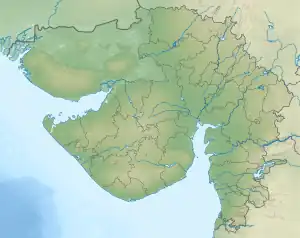 Cambay Shale Formation (Gujarat) | |
Source: Perroleum Geology of the Cambay Basin, India by LR Chowdhary, Indian Petroleum publishes, Dehradun, India.
Paleobiota
Plants
| Plants from the Cambay Shale formation | ||||||
|---|---|---|---|---|---|---|
| Genus | Species | Stratigraphic position | Notes | Images | ||
| Pterospermoxylon | P. suratensis | An angiosperm. | ||||
| Anthocephalophyllum | A. vastanicum | An angiosperm. | ||||
| Ebenoxylon | E. cambayense | An angiosperm. | ||||
| Gardeniophyllum | G. cambayum | An angiosperm. | ||||
| Calophyllaceophyllum | C. eocenicum | An angiosperm. | ||||
| Carallioipollenites | C. integerrimoides | An angiosperm known from fossilised pollen. | ||||
| Gynocardia | G. eocenica | An angiosperm. | ||||
Mammals[1]
| Anthracobunians from the Cambay Shale formation | ||||||
|---|---|---|---|---|---|---|
| Genus | Species | Stratigraphic position | Notes | Images | ||
| Cambaytherium | C. thewissi C. gracilis C. bidens |
A cambaytheriid. | ||||
| Kalitherium | K. marinus | Another cambaytheriid. | ||||
| Indobune | I. vastanensis | A possible anthracobunid. | ||||
| Primates[2] from the Cambay Shale formation | ||||||
|---|---|---|---|---|---|---|
| Genus | Species | Stratigraphic position | Notes | Images | ||
| Asiadapis | A. cambayensis A. tapiensis |
An Asiadapine. | ||||
| Marcgodinotius | M. indicus | Another Asiadapine. | ||||
| Vastanomys | V. gracilis V. major |
A omomyid. | ||||
| Hyaenodonts from the Cambay Shale formation | ||||||
|---|---|---|---|---|---|---|
| Genus | Species | Stratigraphic position | Notes | Images | ||
| Indohyaenodon | I.raoi | A hyaenodont. | ||||
| Dichobunids from the Cambay Shale formation | ||||||
|---|---|---|---|---|---|---|
| Genus | Species | Stratigraphic position | Notes | Images | ||
| Diacodexis | D.indica D.pakistanensis D.parvus |
A Diacodexeine. | 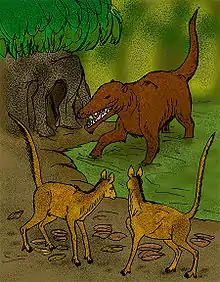 | |||
| Tapiromorphs from the Cambay Shale formation | ||||||
|---|---|---|---|---|---|---|
| Genus | Species | Stratigraphic position | Notes | Images | ||
| Cambaylophus[3] | C. vastanensis | A tapiromorph. | ||||
| Vastanolophus[4] | V. holbrooki | A tapiromorph. | ||||
| Cimolestans from the Cambay Shale formation | ||||||
|---|---|---|---|---|---|---|
| Genus | Species | Stratigraphic position | Notes | Images | ||
| Suratilestes | S. gingerichi | A cimolestan. | ||||
| Anthraconyx | A. hypsomylus | A esthonychid | ||||
| Bats from the Cambay Shale formation | ||||||
|---|---|---|---|---|---|---|
| Genus | Species | Stratigraphic position | Notes | Images | ||
| Archaeonycteris | A. storchi | A bat. | ||||
| Protonycteris | P. gunnelli | A bat. | ||||
| Cambaya | C. complexus | A bat. | ||||
| Hassianycteris | H. kumari | A bat. | ||||
| Icaronycteris | I. sigei | A bat. | ||||
| Jaegeria | J. cambayensis | A bat. | ||||
| Microchiropteryx | M. folieae | A bat. | ||||
| Other mammals from the Cambay Shale formation | ||||||
|---|---|---|---|---|---|---|
| Genus | Species | Stratigraphic position | Notes | Images | ||
| Frugivastodon | F. cristatus | A apatemyid. | ||||
| Indolestes | I. kalamensis | An adapisoriculid. | ||||
| Indodelphis | I. luoi | A opossum. | ||||
| Meldimys[5] | M. musak | A rodent. | ||||
| Indonyctia[6] | I. cambayensis | A nyctitheriid. | ||||
Reptiles
| Birds from the Cambay Shale formation | ||||||
|---|---|---|---|---|---|---|
| Genus | Species | Stratigraphic position | Notes | Images | ||
| Vastanavis | V.eocaena | A parrot. | ||||
| Lizards from the Cambay Shale formation | ||||||
|---|---|---|---|---|---|---|
| Genus | Species | Stratigraphic position | Notes | Images | ||
| Indiagama | I. gujarata | A iguanian. | ||||
| Suratagama | S. neeraae | A iguanian. | ||||
| Tinosaurus | T. indicus | A iguanian. | ||||
| Vastanagama | V. susanae | A iguanian. | ||||
| Heterodontagama | H. borsukae | A priscagamid iguanian. | ||||
| Snakes from the Cambay Shale formation | ||||||
|---|---|---|---|---|---|---|
| Genus | Species | Stratigraphic position | Notes | Images | ||
| Platyspondylophis | P. tadkeshwarensis | A Madtsoiid. | ||||
| Russellophis | R. crassus | A russelophiid. | ||||
| Procerophis | P. sahnii | A snake. | ||||
| Thaumastophis | T. missiaeni | A snake. | ||||
| Palaeophis | P. vastaniensis | A paleophiid snake. | ||||
Amphibians
| Amphibians from the Cambay Shale formation | ||||||
|---|---|---|---|---|---|---|
| Genus | Species | Stratigraphic position | Notes | Images | ||
| Eobarbourula | E. delfinoi | A toad. | ||||
| Indorana | I.prasadi | A frog. | ||||
Arthropods
Crabs
| Crabs from the Cambay Shale formation | ||||||
|---|---|---|---|---|---|---|
| Genus | Species | Stratigraphic position | Notes | Images | ||
| Philyra | P. karkata | A leucosiid crab. | ||||
Insects
| Beetles from the Cambay Shale formation | ||||||
|---|---|---|---|---|---|---|
| Genus | Species | Stratigraphic position | Notes | Images | ||
| Protoclaviger[7] | P.trichodens | A Beetle. | ||||
| Cambaltica | C. paleoindica | A Flea Beetle. | ||||
| Paleosorius | P. cambayensis | A Rove Beetle. | ||||
| Hemipterans[8] from the Cambay Shale formation | ||||||
|---|---|---|---|---|---|---|
| Genus | Species | Stratigraphic position | Notes | Images | ||
| Heteromargarodes | H. hukamsinghi H. americanus |
A sand pearl. | ||||
| Normarkicoccus | N. cambayae | A diaspidid scale insect. | ||||
| Neuropterans from the Cambay Shale formation | ||||||
|---|---|---|---|---|---|---|
| Genus | Species | Stratigraphic position | Notes | Images | ||
| Spiloconis[9] | S. sexguttata S. glaesaria S. oediloma S. eominuta |
A Aleuropterygine Coniopterygid. | ||||
| Bees from the Cambay Shale formation | ||||||
|---|---|---|---|---|---|---|
| Genus | Species | Stratigraphic position | Notes | Images | ||
| Melikertes[10] | M. (Paramelikertes) gujaratensis M. (Melikertes) kamboja |
A bee. | ||||
| Wasps from the Cambay Shale formation | ||||||
|---|---|---|---|---|---|---|
| Genus | Species | Stratigraphic position | Notes | Images | ||
| Trichelyon | T. tadkeshwarense | A braconid wasp. | ||||
| Termites[11] from the Cambay Shale formation | ||||||
|---|---|---|---|---|---|---|
| Genus | Species | Stratigraphic position | Notes | Images | ||
| Nanotermes | N. isaacae | A termitid termite. | 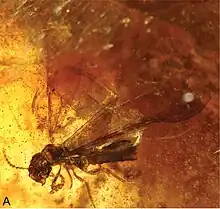 | |||
| Prostylotermes | P. kamboja | A Stylotermitid termite. | 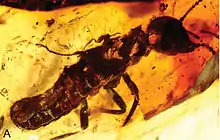 | |||
| Parastylotermes | P. krishnai | A Stylotermitid termite. | 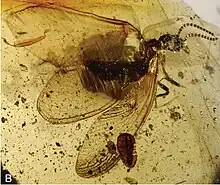 | |||
| Zophotermes | Z. ashoki | A Rhinotermitid termite | ||||
| Flies from the Cambay Shale formation | ||||||
|---|---|---|---|---|---|---|
| Genus | Species | Stratigraphic position | Notes | Images | ||
| Sycorax[12] | S. longistyla | A moth fly. | ||||
| Phlebotoiella | P. eoindianensis | A moth fly of unceritian affinities. | ||||
| Dicranomyia | D. (Dicranomyia) indica | The oldest known Crane fly and tipulomorph.[13] | ||||
| Stempellina | S.pollex S.stebneri |
A non-biting midge | ||||
| Tanytarsus | T.forfex T.ramus |
A non-biting midge | ||||
| Camptopterohelea | C. odora | A non-biting midge | ||||
| Eohelea | E. indica | A biting midge | ||||
| Gedanohelea | G. gerdesorum | A biting midge | ||||
| Indorrhina | I.sahnii | A biting midge | ||||
| Lygistorrhina | L. indica | A biting midge | ||||
| Meunierohelea | M. borkenti | A biting midge | ||||
| Meunierohelea | M. cambayana | A biting midge | ||||
| Meunierohelea | M. orientalis | A biting midge | ||||
| Palaeognoriste | P. orientale | A biting midge | ||||
| Webspinners from the Cambay Shale formation | ||||||
|---|---|---|---|---|---|---|
| Genus | Species | Stratigraphic position | Notes | Images | ||
| Kumarembia | K. hurleyi | One of the few fossil Webspinners known. | ||||
Arachnids
| Whip spiders from the Cambay Shale formation | ||||||
|---|---|---|---|---|---|---|
| Genus | Species | Stratigraphic position | Notes | Images | ||
| Paracharonopsis[14] | P. cambayensis | A Paracharontid. | ||||
Fish
| Whip spiders from the Cambay Shale formation | ||||||
|---|---|---|---|---|---|---|
| Genus | Species | Stratigraphic position | Notes | Images | ||
| Avitoplectus[14] | A. molaris | A bony fish. | ||||
Color key
|
Notes Uncertain or tentative taxa are in small text; |
References
- "Vastan Lignite Mine, Gujarat, India".
- Rose, Kenneth D.; Rana, Rajendra S.; Sahni, Ashok; Kumar, Kishor; Missiaen, Pieter; Singh, Lachham; Smith, Thierry (April 1, 2009). "Early Eocene Primates from Gujarat, India". Journal of Human Evolution. 56 (4): 366–404. doi:10.1016/j.jhevol.2009.01.008. PMID 19303624 – via ScienceDirect.
- Kapur, Vivesh V.; Bajpai, Sunil (December 31, 2015). "Oldest South Asian tapiromorph (Perissodactyla, Mammalia) from the Cambay Shale Formation, western India, with comments on its phylogenetic position and biogeographic implications". Journal of Palaeosciences. 64 ((1-2)): 95–103. doi:10.54991/jop.2015.104. S2CID 252301155 – via jpsonline.co.in.
- https://palaeovertebrata.com/articles/view/344
- "An ailuravine rodent from the lower Eocene Cambay Formation at Vastan, western India, and its palaeobiogeographic implications - Acta Palaeontologica Polonica". www.app.pan.pl.
- Das, Debasis P.; Carolin, Nora; Bajpai, Sunil (July 3, 2022). "A nyctitheriid insectivore (Eulipotyphla, Mammalia) of Asian affinity from the early Eocene of India". Historical Biology. 34 (7): 1157–1165. doi:10.1080/08912963.2021.1966002. S2CID 238735010 – via Taylor and Francis+NEJM.
- "Specialized Myrmecophily at the Ecological Dawn of Modern Ants: Current Biology".
- Vea, Isabelle M.; Grimaldi, David A. (2015). "Diverse New Scale Insects (Hemiptera: Coccoidea) in Amber from the Cretaceous and Eocene with a Phylogenetic Framework for Fossil Coccoidea". American Museum Novitates (3823): 1–15. doi:10.1206/3823.1. S2CID 73702369.
- Grimaldi, David; Engel, Michael S.; Nascimbene, Paul c.; Singh, Hukam (2013). "Coniopterygidae (Neuroptera: Aleuropteryginae) in Amber from the Eocene of India and the Miocene of Hispaniola". American Museum Novitates (3770): 20–39. doi:10.1206/3770.2. S2CID 56567508.
- Engel, Michael S.; Ortega-Blanco, Jaime; Nascimbene, Paul C.; Singh, Hukam (December 17, 2013). "The bees of Early Eocene Cambay amber (Hymenoptera: Apidae)". Journal of Melittology (25): 1–12. doi:10.17161/jom.v0i25.4659. hdl:1808/14444 – via journals.ku.edu.
- Engel, Michael; Grimaldi, David; Nascimbene, Paul; Singh, Hukam (November 21, 2011). "The termites of Early Eocene Cambay amber, with the earliest record of the Termitidae (Isoptera)". ZooKeys (148): 105–123. doi:10.3897/zookeys.148.1797. PMC 3264413. PMID 22287892 – via zookeys.pensoft.net.
- Wagner, Rüdiger; Agnihotri, Priya; Singh, Hukam (August 25, 2022). "A new species of Sycorax (Sycoracinae: Psychodidae) from the Lower Eocene amber of Tadkeshwar, Gujarat, India". Palaeoentomology. 5 (4): 319–326. doi:10.11646/palaeoentomology.5.4.4. S2CID 251861581 – via mapress.com.
- Kania, Iwona; Krzemiński, Wiesław; Stebner, Frauke; Singh, Hukam (June 11, 2016). "The first representative of Tipulomorpha (Diptera) from Early Eocene Cambay amber (India)". Earth and Environmental Science Transactions of the Royal Society of Edinburgh. 107 (2–3): 263–269. doi:10.1017/S1755691017000433. S2CID 134226776 – via Cambridge University Press.
- Engel, Michael S.; Grimaldi, David A. (August 6, 2014). "Whipspiders (Arachnida: Amblypygi) in amber from the Early Eocene and mid-Cretaceous, including maternal care". Novitates Paleoentomologicae (9): 1–17. doi:10.17161/np.v0i9.4765 – via journals.ku.edu.
This article is issued from Wikipedia. The text is licensed under Creative Commons - Attribution - Sharealike. Additional terms may apply for the media files.